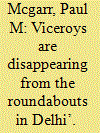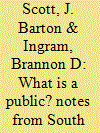|
|
|
Sort Order |
|
|
|
Items / Page
|
|
|
|
|
|
|
| Srl | Item |
| 1 |
ID:
139688


|
|
|
|
|
| Summary/Abstract |
In the aftermath of the Second World War, as post-colonial regimes in Africa and Asia hauled down imperial iconography, to the surprise and approval of many Western observers, India evidenced little interest in sweeping away remnants of its colonial heritage. From the late 1950s onwards, however, calls for the removal of British imperial statuary from India's public spaces came to represent an increasingly important component in a broader dialogue between central and state governments, political parties, the media, and the wider public on the legacy of British colonialism in the subcontinent. This article examines the responses of the ruling Congress Party and the British government, between 1947 and 1970, to escalating pressure from within India to replace British statuary with monuments celebrating Indian nationalism. In doing so, it highlights the significant scope that existed for non-state actors in India and the United Kingdom with a stake in the cultural politics of decolonization to disrupt the smooth running of bilateral relations, and, in Britain's case, to undermine increasingly tenuous claims of continued global relevance. Post-war British governments believed that the United Kingdom's relationship with India could be leveraged, at least in part, to offset the nation's waning international prestige. In fact, as the fate of British statuary in India makes clear, this proved to be at least as problematic and flawed a strategy in the two decades after 1947 as it had been in those before.
|
|
|
|
|
|
|
|
|
|
|
|
|
|
|
|
| 2 |
ID:
140454


|
|
|
|
|
| Summary/Abstract |
In South Asia, as elsewhere, the category of ‘the public’ has come under increased scholarly and popular scrutiny in recent years. To better understand this current conjuncture, we need a fuller understanding of the specifically South Asian history of the term. Toward this end, our discussion begins by considering more than two decades of scholarship that have worked to excavate this history. We propose that two principal methods or approaches—the genealogical and the typological—have characterised this scholarship. We then suggest, more in the mode of genealogy, that the category of the public has been closely linked to the subcontinental history of political liberalism. Finally, we discuss how the essays collected in this special issue challenge some of liberalism's key presuppositions about the public and its relationship to law and religion.
|
|
|
|
|
|
|
|
|
|
|
|
|
|
|
|
|
|
|
|
|